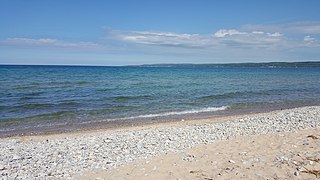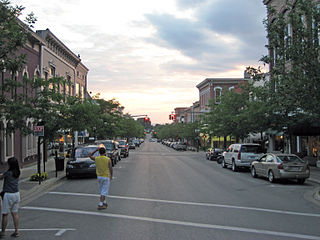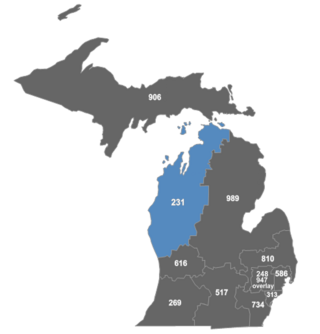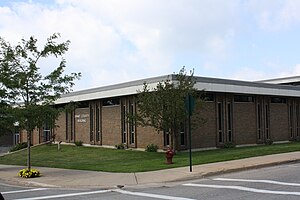
Mackinac County is a county in the Upper Peninsula of the U.S. state of Michigan. As of the 2020 census, the population was 10,834. The county seat is St. Ignace. Formerly known as Michilimackinac County, in 1818 it was one of the first counties of the Michigan Territory, as it had long been a center of French and British colonial fur trading, a Catholic church and Protestant mission, and associated settlement.

Cheboygan County is a county in the U.S. state of Michigan. As of the 2020 census, the population was 25,579. The county seat is Cheboygan. The county boundaries were set off in 1840, with land partitioned from Michilimackinac County. The Cheboygan County government was organized and combined with the former Wyandot County in 1853.

Charlevoix County is a county in the U.S. state of Michigan. The county seat is Charlevoix, and the largest city is Boyne City. Located in the Northern Lower Peninsula, Charlevoix County is bisected by Lake Charlevoix, Michigan's third largest inland lake. As of the 2020 census, the county's population was 26,054.

Charlevoix is a city in the U.S. state of Michigan. It is the county seat of Charlevoix County. Part of Northern Michigan, Charlevoix is located on an isthmus between Lake Michigan and Lake Charlevoix, bisected by the short Pine River. Charlevoix serves as the main access point for Beaver Island, the largest island in Lake Michigan, which can be accessed by Island Airways or carferry. The population of Charlevoix was 2,348 at the 2020 census. Charlevoix is mostly surrounded by Charlevoix Township, but the two are administered autonomously.

Bear Creek Township is a civil township of Emmet County in the U.S. state of Michigan. As of the 2020 census, the township population was 6,542, making it the most populous municipality in Emmet County.

Harbor Springs is a city and resort community in Emmet County, Michigan, United States. The population was 1,274 in the 2020 census.

Petoskey is a city in the U.S. state of Michigan. It is the county seat of Emmet County, and is the largest settlement within the county. Petoskey has a population of 5,877 at the 2020 census, up from 5,670 at the 2010 census.

Resort Township is a civil township of Emmet County in the U.S. state of Michigan. The southwesternmost township of Emmet County, Resort Township is immediately adjacent Petoskey, the county seat and largest city in Emmet County. Resort Township also has a shoreline on Little Traverse Bay, a bay of Lake Michigan. At the 2020 census, the population was 2,835, an increase from 2,697 at the 2010 census.

St. Ignace is a city in the U.S. state of Michigan and the county seat of Mackinac County. The city had a population of 2,306 at the 2020 census. St. Ignace Township is located just to the north of the city, but the two are administered autonomously.

Mackinaw City is a village at the northernmost point of the Lower Peninsula of Michigan, United States. Divided between Cheboygan and Emmet counties, Mackinaw City is located at the southern end of the Mackinac Bridge, which carries Interstate 75 over the Straits of Mackinac to the Upper Peninsula. Mackinaw City, along with St. Ignace, serves as an access point to Mackinac Island. For these reasons, Mackinaw City is considered one of Michigan's most popular tourist attractions.

Wawatam was an 18th-century Odawa chief who lived in the northern region of present-day Michigan's Lower Peninsula in an area along the Lake Michigan shoreline known by the Odawa as Waganawkezee.

Little Traverse Bay is a small open bay of Lake Michigan. Extending about 10 miles (16 km) into the Lower Peninsula of Michigan, much of the head of the land surrounding Little Traverse Bay, and has become part of the urban areas of Petoskey and Harbor Springs. Little Traverse Bay primarily lies within Emmet County, although a small portion lies within Charlevoix County.

Northern Michigan, also known as Northern Lower Michigan, is a region of the U.S. state of Michigan. A popular tourist destination, it is home to several small- to medium-sized cities, extensive state and national forests, lakes and rivers, and a large portion of Great Lakes shoreline. The region has a significant seasonal population much like other regions that depend on tourism as their main industry. Northern Lower Michigan is distinct from the more northerly Upper Peninsula and Isle Royale, which are also located in "northern" Michigan. In the northernmost 21 counties in the Lower Peninsula of Michigan, the total population of the region is 506,658 people.

Area code 231 is a telephone area code in the North American Numbering Plan (NANP) for the northwestern portion of the Lower Peninsula in the U.S. state of Michigan,

The Little Traverse Bay Bands of Odawa Indians is a federally recognized Native American tribe of Odawa. A large percentage of the more than 4000 tribal members continue to reside within the tribe's traditional homelands on the northwestern shores of the state of Michigan's Lower Peninsula. The historically delineated reservation area, located at 45°21′12″N84°58′41″W, encompasses approximately 336 square miles (870 km2) of land in Charlevoix and Emmet counties. The largest communities within the reservation boundaries are Harbor Springs, where the tribal offices are located; Petoskey, where the Tribe operates the Odawa Casino Resort; and Charlevoix.
L'Arbre Croche, known by the Odawa people as Waganagisi, was a large Odawa settlement in Northern Michigan. The French called it L'Arbre Croche for the large crooked tree that marked the center of the settlement and was visible for many miles. It covered the region from Harbor Springs to Cross Village in present-day Emmet County, Michigan.

Michigan's 37th Senate district is one of 38 districts in the Michigan Senate. The 37th district was created with the adoption of the 1963 Michigan Constitution, as the previous 1908 state constitution only permitted 34 senatorial districts. It has been represented by Republican John Damoose since 2023, succeeding fellow Republican Wayne Schmidt.
Mackinaw City Public Schools is a school district headquartered in Mackinaw City, Michigan. It consists of one school: Mackinaw City K-12 School.

The Northern Shores Conference is an upcoming interscholastic athletic conference affiliated with the Michigan High School Athletic Association. It is set to begin play during the 2024–2025 school year. It is located in Northern Michigan and contains eight teams that encompasses seven counties: Antrim County, Charlevoix County, Cheboygan County Crawford County, Emmet County, Grand Traverse County, and Kalkaska County.


























